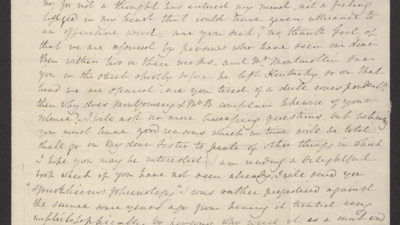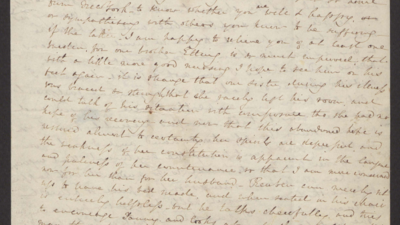Oral History Interview with Liesl Loeb
Title
Date
Contributor
Summary
Liesl Joseph Loeb was born on June 17, 1928 in Rheydt, Rhineland, Germany. Liesl, together with her father, Josef Joseph, an attorney, and her mother, Lilly Salmon Joseph, was a passenger on the S.S. St. Louis. This German luxury Liner sailed on May 13, 1939, from Hamburg toward Havana, Cuba, with 937 Jewish refugees on board.
Liesl speaks about her family background and life leading up to Kristallnacht which she experienced, hiding in her own home while Nazi hoodlums were vandalizing it. She describes the months leading up to embarkation and conditions which had to be met before leaving Germany and immigration into Cuba, which was to be temporary until the family’s quota number was called for the United States.
She describes the trip and its complications from a child’s perspective. She speaks of her father’s sense of duty as the chairman of the passenger committee and the commitment and devotion of all its members. The desperate situation of the hapless passengers to whom no country offered a haven, especially not the United States, is emphasized. After 40 days at sea, the passengers are rescued through the efforts of the American Jewish Joint Distribution Committee (JDC), by four countries - England, Holland, France, and Belgium.
Finally the Joseph family lands in England, and their life as World War II began is described. The destiny of most of the passengers who were taken in by Holland, France and Belgium ended in tragedy when these countries were invaded by the Nazis.
She describes attending school as an “evacuee”, the internment of her father on the Isle of Man as an enemy alien and arrival in New York on September 10, 1940. She concludes with her graduation from high school, and her immediate marriage thereafter. Several footnotes pursuant to the St. Louis story are added at the end of this memoir.
Self-taped oral memoir: LOEB, Liesl Joseph Date: Nov. 17, 1998
no publication without Ms. Loeb's permission during her lifetime
More Sources Like This
of
Dora Langsam
Dora Langsam was born in Brzeziny, Poland January 1, 1925. Her family kept kosher, her father, a business man, fought with Trumpeldor, her brother served in the Polish army.
She describes conditions for Jews after the German invasion in September 1939. One brother died trying to protect his father from the Germans, one sister with her newborn baby was taken during a selection. The rest of the family stayed in the Brzeziny Ghetto from 1940 to the spring of 1942 when the ghetto was closed and the Jewish population was transported to the Lodz Ghetto. Her mother was taken away in a selection immediately, a brother later. Dora and her father worked in a factory as slave laborers. She describes what she refers to as “hellish conditions” in the Lodz Ghetto.
In July or August 1944, the liquidation of the ghetto started. Dora, her father, and a sister were transported to Auschwitz. Her father was taken away as soon as he got off the train. Dora and her sister lived in barracks, supervised by a brutal Czech KAPO and endured daily Appells, selections, hunger and cold. Dora tried to rescue her sister during a selection and both were saved from certain death at the last second by an air raid. Both were transported to a labor camp in Neukölln to work in an ammunition factory owned by Krupp. In 1945, near the end of the war, they were transported to Ravensbrück where they received food packages from the American Red Cross. Dora and her sister did not get sick like most of the girls because they didn’t eat the non-kosher food.
On April 24, 1945 Dora and her sister went to Padborg, Denmark on a convoy organized by Folke Bernadotte, then on to Copenhagen and Malmö, Sweden. She describes how deeply being treated like human beings affected them and the quarantines in Lund then Visingsö. Dora worked in a sanatorium during the day and went to school at night, stayed in Sweden for eight years, married her husband, a survivor from Poland, and had a son and a daughter during that time. On July 6, 1953 they went to the United States, helped by HIAS, because her husband wanted to raise his children in a free country. Her sister still lives in Sweden with her husband, also a survivor.
of
Charlotte Bing
Charlotte Bing was born in 1918 in Bielsko (Bielitz), Poland, a textile town near the German border. Charlotte describes her town and explains that most of the 8,000 Jews were financially well off. She details her schooling at a Jewish school for four years and then at a German high school. She discusses pre-war antisemitism and also the good relations between the rabbi and the Catholic priest, but that the priest would not step in to say anything about his parishioners hurting Jews unless the rabbi requested it of him.
Charlotte recounts that in 1938 Polish Jews living in Germany—who were deported back to Poland—were helped by the Jews of Bielsko. She vividly recalls the blatant antisemitism exhibited by Polish citizens when Germans took over the city and the anti-Jewish measures that began. The SS rounded up all of the Jewish men. Jews were ordered to give up their money and gold. Jewish children could not go to school and Jewish stores were not permitted to operate. Her family fled to Wadowice thinking that the Germans would not come further into Poland, but were again forced to flee after six weeks. Charlotte describes the escape of her family and her fiancée to Krakow. After a year in Krakow, the entire Jewish community was deported to the Plaszow Ghetto. Charlotte describes in detail the creation of the ghetto, conditions, forced labor, scarcity of food, and the clandestine education of children. She describes how work at menial jobs was organized by Germans, assisted by selected members of the Jewish community.
At the end of 1942 Charlotte and her husband were transferred to the Majdanek concentration camp Charlotte describes their arrival (in sealed cars, no food/water, toilet). She witnessed atrocities (including the killing of a baby) upon their arrival. She details her work as translator and laying rail lines and an injury that never healed, as well as conditions in the camp. She also details frequent visits by Adolph Eichmann.
The Soviet army liberated the camp in July – August 1944 and the first Jewish community in Europe was formed nearby. Food and clothing came from the Russians and from Jews living in Palestine. Charlotte describes the immense difficulty faced by people who came to reclaim children taken in by Polish families and children searching for their parents. She details post-war threats by Poles (liberated Polish political prisoners known as ACOFTA), who targeted her husband. She describes their flight through Krakow and Czechoslovakia to Germany and recounts their very difficult time getting visas to emigrate to the United States. In October of 1945 they secured menial work on a U.S. Military transport plane as a means of coming to the United States, where they joined family in New York.
of
Sybil A. Niemöeller
Sybil Niemöller (maiden name von Sell) was born in 1923 in Potsdam into an aristocratic Prussian family. Both her grandfathers were Prussian generals. After World War I her father was appointed by Kaiser Wilhelm to be his financial advisor and administrator. She grew up in Berlin-Dahlem where she had several Jewish friends. Her parents were strongly anti-Nazi. The family attended the Confessing Church which was led by their friend Pastor Niemöller. This church was founded as counterpart against the Christian German Church which had embraced Nazi ideology. Because she did not belong to the Hitler Youth she was prevented from graduating from high school and became an actress. During the war her parents sheltered several Jews, disguised as seamstresses and gardeners. Two of her cousins, Werner von Haeften (who was adjutant to Count von Stauffenberg) and Hans Bernd von Haeften were involved in the attempt on Hitler’s life in 1944 and were executed. Both Sybil and her father were also arrested and interrogated at that time, but released. She arrived in the United States in 1952, became a U.S. citizen in 1957, and married Pastor Martin Niemöller. She accompanied him on his lecture tours but made their home in Wiesbaden, Germany. She describes his suffering as “Hitler’s special prisoner” when he was incarcerated in Sachsenhausen and later in Dachau.
Interviewee: NIEMÖLLER, Sybil (von Sell) Date: November 21, 1986
of
Jacques Lipetz
Jacques Lipetz was born in Antwerp, Belgium, 1932. He was educated at Takhemoni, a Jewish school. He relates many childhood memories. He vividly describes his family’s flight through France to Marseille in May 1940. Jacques, his mother and two brothers went to Lisbon via Spain, his father via Morocco. An interesting vignette explains how he managed to join his family.
Jacques and his family sailed to New York City in 1941 but could not stay because their quota number had not come up yet. They booked passage to the Philippines and landed in Manila in May or June 1941. He describes their life as Belgian subjects under Japanese occupation. Jacques attended a private school run by the Christian Brothers, and describes his religious education as a Sephardic Jew in a congregation dominated by Ashkenazic German Jews, as well as antisemitic persecution by Filipino students. He gives an interesting account of Japanese cultural attitudes and their treatment of foreigners and natives. The Japanese brought civilian Jewish internees to High Holiday services. He tells a charming story of how a Japanese officer helped his brother get his scooter back from a German Nazi family. Jacques describes conditions in Manila towards the end of the war and liberation by Americans. Jewish chaplains held a Passover Seder for the Jewish community at the Manila racetrack. The Lipetz family left Manila for America in late 1945 and received a permanent visa five years later.
Historical endnotes by Dr. Michael Steinlauf are in the transcript.
Interviewee: LIPETZ, Jacques Date: July 21, 1988

